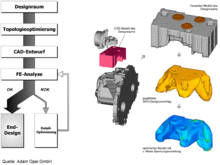SKO (bionics)
The SKO method (Soft Kill Option), like the CAO method (CAO: Computer Aided Optimization), is based on the simulation of the growth rule of biological power carriers and is therefore a method from the field of bionics .
In contrast to the CAO method, however, the growth rule is not only applied to the surface of a component, but also to the inner area. This means that holes can arise within the component. Since the introduction of holes changes the topology of the component from a mathematical point of view , this type of optimization is called topology optimization . A special feature of the topology optimization is that the holes are not mapped using the shape of the finite element model (FEM) network, but are simulated within the network using a material property of the individual elements, the modulus of elasticity . The modulus of elasticity is a measure of the rigidity and can be varied individually in each element of the FEM network. If the modulus of elasticity is very small, the element is very soft and therefore behaves physically like a hole. If, on the other hand, it has the value of the material used, it is massive and shows the desired material behavior. The growth rule determines what value the individual elements receive or, in other words, where holes should and where not. As with the CAO method, the measure is the difference between the voltage of the individual element and the reference voltage . It serves as a measure of how much and in which direction the modulus of elasticity has to be modified in a growth cycle.
The process is terminated when a stable structure has formed. Since the biological growth rule is simulated at SKO, this process delivers a structure with homogeneous surface tension. It is therefore, like CAO, suitable for strength problems.
Due to the fact that the shape of the topology optimization is described solely through the distribution of a material property, this type of optimization is very flexible. However, since the material can only be added or removed element by element, in contrast to the CAO process, you do not receive a detailed design, but a design proposal that can be very rough. A further complicating factor is that the determined design not only has elements with maximum and minimum modulus of elasticity, but also elements with intermediate values. In order to be able to graphically represent the massive area, the user must therefore define the limit from which an element is to be regarded as massive.
Applications
One can distinguish between three areas of application of topology optimization. The simplest application is to determine the position and shape of holes in components in order to reduce their weight. The second area of application is to find the best possible arrangement of beads in sheet metal. The third area of application is the determination of the optimal characteristics of components or component groups. This allows you to determine in the concept phase in which areas material is required or where structures need to be built. In addition, the optimal cross-section and the optimal number and arrangement of ribs in cast parts can also be determined in great detail .
The SKO process has proven itself particularly in the optimization of cast parts. Experience shows that the determination of optimal features is of the utmost importance for cast parts. If these are not optimal for a component, shape optimization can usually only marginally improve the component. The optimal features are therefore the basis for an optimal component and only determine the optimization potential.
The sequence of such a casting optimization is shown in the figure. Instead of a detailed component, the designer only generates a CAD model of the available installation space, also known as the design space. Based on the design space, a topology optimization is carried out in order to define the most important features of the component, such as cross-section and rib arrangement. Only then is a detailed CAD model of the component created, which is calculated for control purposes and, if necessary, fine-tuned.
The implementation of the design proposal is always the most difficult step and the particular challenge in topology optimization, because a component has to be derived from the design proposal that on the one hand is castable, but on the other hand should come as close as possible to the design proposal. Since a bone has no problem with manufacturing restrictions, but simply grows into the optimal shape, the growth rule usually provides design suggestions that can never be implemented directly in terms of manufacturing. In order to improve this situation, TopShape was developed in which, in addition to the biological growth rule, the simplest production restrictions for cast parts are also taken into account.
literature
- C. Mattheck: Design in nature. Rombach GmbH + Co Verlagshaus KG, Freiburg i. B., 1997, ISBN 3793091503
- Baumgartner, L. Harzheim, C. Mattheck: SKO (Soft Kill Option): The Biological Way to Find an Optimum Structure Topology. Int J Fatigue 14 No 6, 1992, 387-393
- L. Harzheim, G. Graf: A Review of Optimization of Cast Parts Using Topology Optimization: I - Topology Optimization without Manufacturing Constraints. Struct Multdisc Optim 30, 2005, 491-497
- L. Harzheim: Structure optimization, fundamentals and applications. Scientific publishing house Harri Deutsch GmbH, Frankfurt am Main, 2007, ISBN 978-3-8171-1809-0



